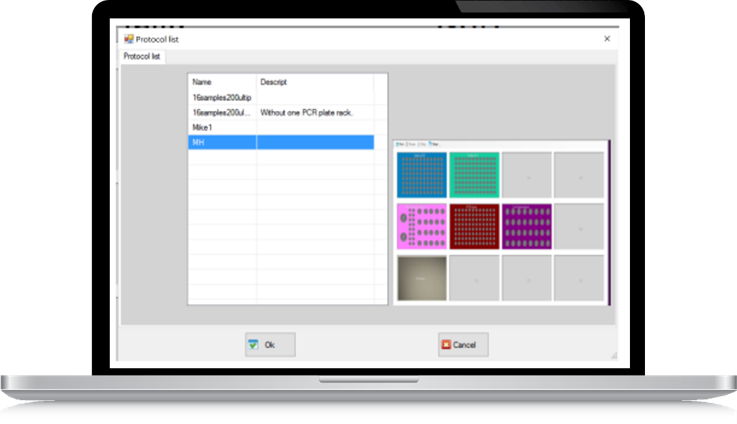THERMAL CYCLER PCR

Speed
Rob™ has two modes for doing qPCR set-up. Traditional mode uses one tip for every sample replicate and OneDip™ mode uses the same tip for all replicates doing serial dispensing. The example below is based on a qPCR set-up with three replicates and pre-made master mix.
One tip per replicate
96-plate: 27 minutes (18 µl mix + 2 µl sample)
384-plate: 95 minutes (5 µl mix + 2 µl sample)
OneDip™
96-plate: 13 minutes (18 µl mix + 2 µl sample)
384-plate: 45 minutes (5 µl mix + 2 µl sample)
Rob™ handles a 384 set-up with acceptable speed but with low investment cost.
Software features
- qPCR set-up guide is a stepwise quide to design the protocol of qPCR experiment, optimize the use of reagents, several Master Mixes
- Serial dilution maximizes the accuracy of pipetting for serial dilution
- Sample normalization simply input two information, sample volume and concentration
Accuracy & Precision
Accuracy and precision data obtained under optimized conditions may not be possible to reproduce in your application. The data below were obtained under normal QPCR set-up conditions. On the other hand, high precision data indicates that the liquid handling is stable. Market leading precision can easily be reproduced at your lab. High precision and accuracy also grants that dispense performance is very robust. Changes in viscosity will not have the same impact on dispensed volume seen in competing systems. So the dispense data below is what you can expect from Rob™ in reality.
50 µl pipette tip with filter
| Volume (µl) | Mean (µl) | Precision (C.V.) |
| 1 | 1.00 | 3.78 |
| 2 | 1.99 | 1.83 |
| 5 | 5.00 | 0.76 |
| 10 | 10.02 | 0.38 |
Ten single dispenses in ten PCR tubes (0.2 ml).
50 µl pipette tip with filter, OneDip™
| Volume (µl) | Mean (µl) | Precision (C.V.) |
| 2 | 2.03 | 1.93 |
| 5 | 5.05 | 1.67 |
Three series dispenses in 3 x3 PCR tubes. Tubes were pre-filled with 15 µl master mix to mimic a qPCR set-up.
Liquid Level Detection (LLD)
It is essential to have in-process LLD and tip detection to verify processed protocols. There are two methods used to measure the liquid level heights. Either conductive or pressure based systems are used. The advantages of pressure based LLD are that all liquids can be detected and the system isn’t sensitive for static electricity. Conductive measurements require expensive conductive tips, is sensitive to static electricity but measures faster.
Rob™ uses a further developed pressure based LLD that has improved detection speed. The LLD system provides with better precision and sensitivity than needed.
Detection limit: Detects as low 3 µl in a 200 µl PCR tube.
Detection precision: ± 0.3 µl in a PCR tube with 20 µl volume.
| Pipette head | 0.5 - 200 µl single channel |
| Dispense modes | Single- and multi-dispense modes |
| Precision | CV < 2% for 2µl, dry dispense. CV < 1% from 5 µl, dry dispense |
| Accuracy | CV < 2% from 2 µl. CV 1 % from 5 µl. |
| Liquid level tracking | Pressure based detects volumes from 3 µl in 200 µl PCR tubes. |
| Pipette tips | Clear 50 or 200 µl with or without filter in racks. |
| Tip waste handling | Automatic tip ejection. Ejected tips are collected externally. |
| Deck capacity | 11 SBS micro plate positions and one tip waste position. |
| Motor resolutions | X and Y < 0.01 mm, Z < 0.05 mm. |
| Dimensions | 663 X 516 X 571 mm (w x d x h) |
| Weight | 35 kg. Shipping weight is 60 kg. |
| Communication | USB |
| Software | Supplied with unlimited user license. Free upgrades. |
| Computer requirements | Win7, 8. or 10. 32 or 64-bit i3. or better 8 Gb RAM. |
| Warranty | One year on instrument |
There is no video for this product now.
Please comback later, thank you!
Related products










